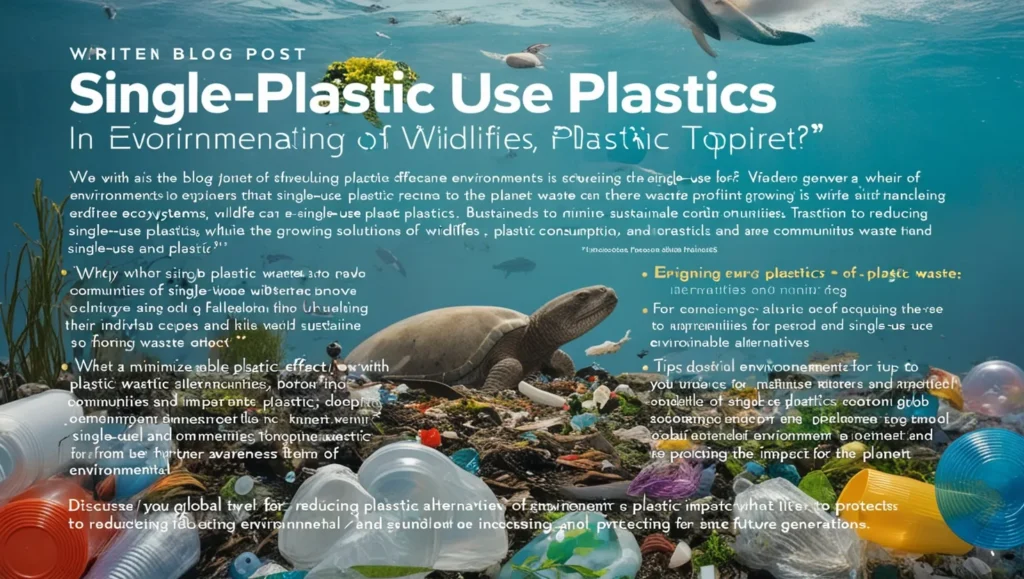Environmental Impact of Single Use Plastics
In recent years, the use of single-use plastics has skyrocketed, creating a significant environmental problem. Items like plastic straws, shopping bags, bottles, and packaging are designed for convenience, but their disposable nature comes with hidden costs to the planet. Environmental Impact of Single Use Plastics This blog delves into the environmental impact of single-use plastics and explores ways we can mitigate their damaging effects on the Earth.
What Are Single-Use Plastics?
Single-use plastics are items made from plastic that are used once and then discarded. These items serve a temporary purpose, such as holding food or beverages, or for other consumer products, but they don’t biodegrade and take hundreds of years to decompose. Common examples of single-use plastics include:
- Plastic straws
- Plastic bags
- Water bottles
- Coffee cup lids
- Packaging materials
- Takeout containers
Because these items are used briefly but persist in the environment for a long time, they contribute significantly to pollution.
The Environmental Toll of Single-Use Plastics
- Landfill Overflow
Most single-use plastics end up in landfills, where they take hundreds of years to break down. As they do, they release toxic chemicals into the soil and water, contributing to pollution. Environmental Impact of Single Use Plastics According to some studies, plastics make up a large portion of landfill waste, with millions of tons being added each year. - Ocean Pollution
One of the most alarming effects of single-use plastics is their impact on the oceans. Plastic waste is often carried by wind and water to the ocean, where it harms marine life. Sea creatures can become entangled in plastic waste, or mistake it for food, leading to injury or death. Some plastics also leach harmful chemicals into the water, further affecting marine ecosystems. - Wildlife Dangers
Land and sea animals alike suffer from plastic pollution. Turtles, whales, seabirds, and other wildlife may ingest plastic debris, which can block their digestive systems and cause malnutrition, suffocation, or even death. This poses a serious threat to biodiversity, as many species are pushed to the brink of extinction due to plastic ingestion. - Non-Biodegradability
Plastics are made from synthetic polymers, which are not biodegradable. They do not break down naturally, unlike organic materials. This leads to the accumulation of plastic waste over time, further exacerbating environmental damage. Environmental Impact of Single Use Plastics Microplastics, which are tiny pieces of plastic less than five millimeters in length, are particularly dangerous as they can infiltrate ecosystems and enter the food chain.
The Global Scale of the Problem
The global plastic crisis is massive, with an estimated 300 million tons of plastic produced annually. More than 8 million tons of plastic enter the oceans each year, and if current trends continue, this number is expected to increase. Despite growing awareness and efforts to reduce plastic consumption, plastic production and waste continue to rise, primarily driven by the convenience and low cost of single-use plastics.
What Can Be Done to Reduce the Environmental Impact?
- Opt for Reusables
One of the simplest ways to reduce your environmental impact is to replace single-use plastics with reusable alternatives. Bring your own reusable bags, bottles, and containers when shopping or eating out. Environmental Impact of Single Use Plastics Stainless steel, glass, and bamboo options are sustainable and durable alternatives. - Support Brands with Sustainable Practices
Many companies are adopting sustainable packaging solutions, such as using biodegradable, recyclable, or compostable materials. Supporting these companies sends a message that sustainability is important to consumers, encouraging other businesses to follow suit. - Avoid Plastic Straws and Cutlery
Plastic straws and cutlery are commonly used for only a short time before being discarded. Opt for reusable alternatives like stainless steel or bamboo straws and utensils. Many cafes and restaurants are now offering sustainable options, and some cities have banned plastic straws altogether. - Educate and Advocate
Spread awareness about the dangers of single-use plastics and encourage others to make eco-friendly choices. Participate in campaigns or advocate for local policies that reduce plastic waste, such as banning plastic bags or straws. The more people who understand the environmental impact, the more collective action can be taken. - Support Plastic Waste Cleanup Initiatives
Join or support organizations and initiatives focused on cleaning up plastic pollution from beaches, rivers, and oceans. These efforts help mitigate the impact of existing waste while raising awareness of the problem. - Participate in Recycling Programs
Proper disposal and recycling of plastic materials is crucial in reducing the amount of plastic that ends up in landfills and the oceans. Learn your local recycling rules and make sure to recycle plastic products whenever possible.
The Future of Plastics: Moving Toward a Circular Economy
While reducing the use of single-use plastics is crucial, a long-term solution lies in transitioning to a circular economy, where plastic products are reused, repaired, and recycled rather than discarded after a single use. Innovative technologies and businesses focused on creating closed-loop systems can help ensure that plastics are put to good use and don’t become waste.
Some companies have already made significant strides toward this, producing biodegradable or compostable plastics, and implementing zero-waste practices. However, it will take widespread collaboration between consumers, businesses, and governments to make the circular economy a reality.
Final Thoughts
The environmental impact of single-use plastics is undeniable, and it’s clear that urgent action is needed to protect our planet. By reducing plastic consumption, choosing reusable options, supporting sustainable brands, and engaging in cleanup efforts, we can collectively make a significant difference. Remember, small changes in our everyday habits can lead to a more sustainable future for the generations to come.
If you’re interested in further exploring how you can reduce your plastic footprint and live a more sustainable lifestyle, consider adopting more eco-friendly alternatives in your daily routine. The choices we make today will shape the world of tomorrow.

